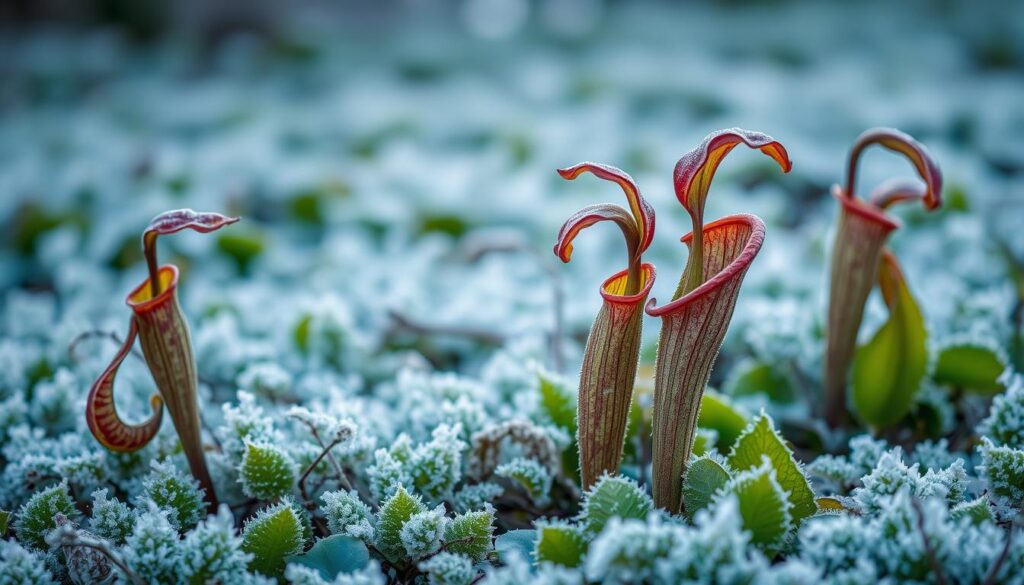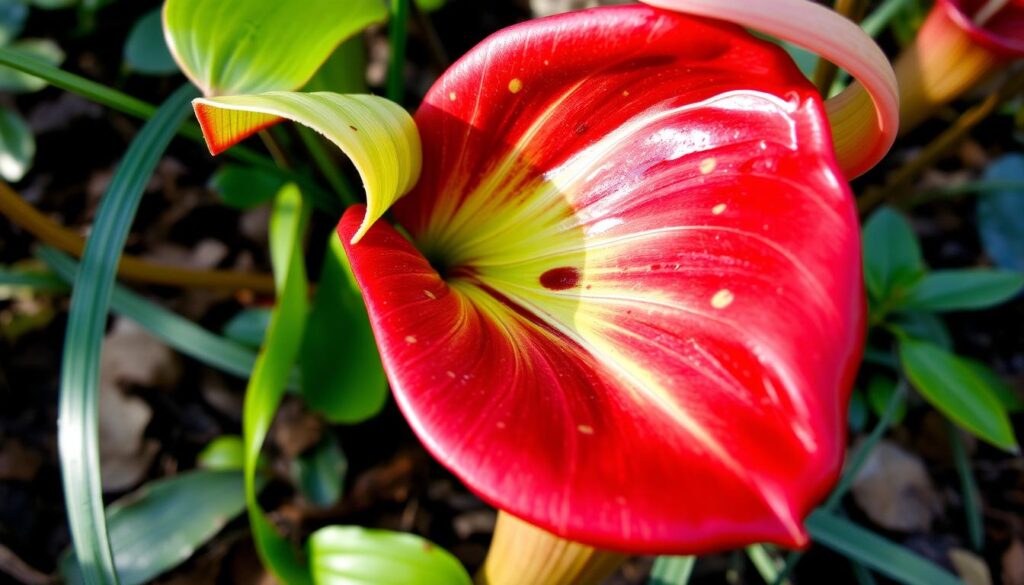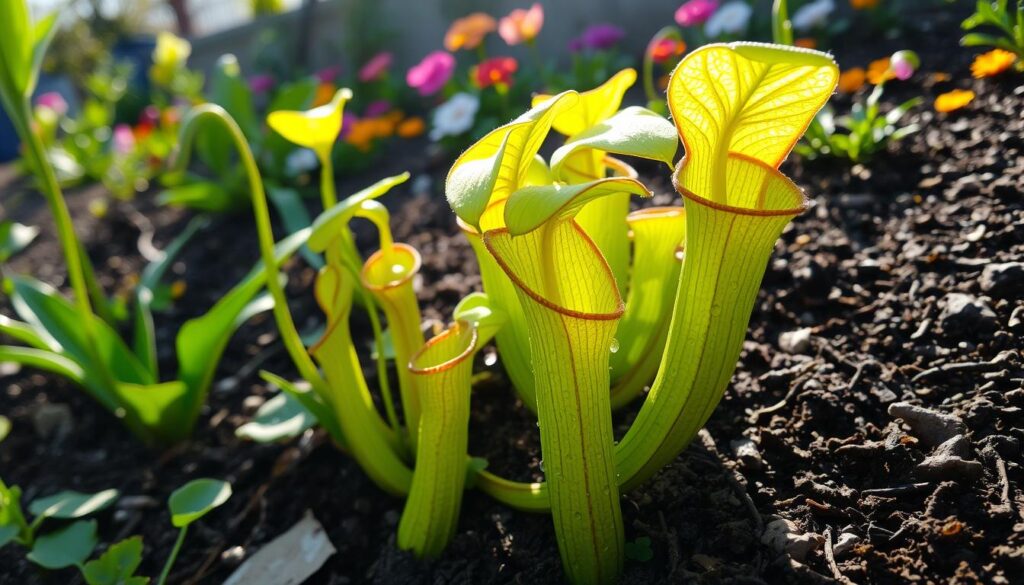For gardeners and plant lovers, knowing about water pitcher plant dormancy is key. The water pitcher plant needs special care during this time. This period is not just for rest; it’s a survival strategy for these plants.
Experts recommend giving these plants at least 45 days of chill at 45°F (7°C), which is especially important for older plants. Younger ones might not need it as much. Taking good care of your water pitcher plants during dormancy helps them stay healthy and catch insects effectively when they wake up.
Table of Contents
Understanding Pitcher Plants and Their Habitats
Pitcher plants are fascinating because of their unique features and where they live. They belong to the Sarracenia genus and have leaves shaped like pitchers. These plants trap and digest insects to get nutrients from poor soil.
What Are Pitcher Plants?
Pitcher plants are a group of carnivorous plants found in North America. They include species like Sarracenia flava and Sarracenia purpurea. These plants live in wetlands with sandy and peaty soil, which keeps them moist.
Their leaves can grow up to 8 inches long and stand upright. This helps them catch insects and even small aquatic animals.
Natural Environments of Pitcher Plants
Pitcher plants live in wetland areas like bogs, swamps, and marshes. These places have acidic soil and are often wet. Gardeners need to mimic these conditions to care for pitcher plants.
Unfortunately, 97.5% of Parrot Pitcher Plants’ habitats in the southeastern U.S. have been lost. This has made many species endangered. Efforts are being made to protect these wetlands and keep the Sarracenia distribution diverse.
The Concept of Dormancy in Plants
Ponytail palms and carnivorous plants, including the water pitcher plant, have survival strategies for tough times. One key tactic is plant dormancy, where growth slows down a lot. This is vital for water pitcher plants in temperate climates. During dormancy in water pitcher plants, saving energy is key for survival.
What is Plant Dormancy?
Plant dormancy protects plants from cold or dry spells. Plants go through dormancy phases that can last weeks or months. In cooler areas, winter dormancy is critical, helping plants adjust to less light and cold.
Different Types of Dormancy
There are many types of dormancy, based on what triggers it and how long it lasts:
- Winter Dormancy: Important for plants in temperate climates, lasting from late October to March.
- Summer Dormancy (Estivation): Some plants sleep through the heat or dry spells.
- Induced Dormancy: This is caused by harsh conditions, helping plants save energy.
For instance, pitcher plants keep their tubes for up to two years. But, they turn brown at the top during dormancy. Knowing about dormancy mechanisms helps gardeners care for their plants better. This ensures plants can get through tough times and grow strong again next season.

Why Do Pitcher Plants Enter Dormancy?
Pinger plants go dormant mainly because of changes in the seasons, like fall and winter. These changes trigger important physical changes. These changes help the plants survive and stay healthy.
Seasonal Changes and Environmental Cues
The dormancy of pitcher plants happens when the seasons change a lot. When it gets colder and darker, the plants know it’s time to slow down. This is a key part of their life cycle.
Pitcher plants from cooler areas need 3 to 5 months of sleep. The cold and short days tell them it’s time to rest. During this time, they save energy and stay strong, which helps them live longer.
Energy Conservation Strategies
When they’re dormant, pitcher plants slow down a lot. This helps them save energy and use their resources wisely. They use old leaves for nutrients and make fewer pitchers. They also need less water.
It’s key to keep the water level right for water pitcher plants, about 1 inch deep. This helps them stay alive during dormancy. The ways water pitcher plants protect themselves during this time help them grow strong again when conditions improve outside. Knowing about dormancy helps gardeners take better care of these remarkable plants.
Signs Your Pitcher Plant is Going Dormant
It’s important to know when your pitcher plant is going dormant. During this time, they show clear signs. Gardeners need to watch for these changes to care for their plants right.
Changes in Leaf Color and Texture
When pitcher plants get ready to go dormant, their leaves change. They might look duller and turn brown. This means the plant is getting ready for a rest.
The leaves also get dry and less flexible. This is a sign that the plant needs less water and care. These signs help gardeners know how to take care of their plants during this time.
Decreased Growth and Pitcher Production
A big sign of dormancy is when the plant grows less. You’ll see fewer new pitchers forming. Existing ones might start to turn brown.
This slowdown is a clue that the plant needs a break. It’s important to adjust how you water and care for it. This helps the plant rest well.

| Sign of Dormancy | Description | Action Required |
|---|---|---|
| Leaf Color Change | Dullness and browning of leaves | Reduce watering and monitor humidity |
| Texture Alteration | Leaves become dry and brittle | Adjust care routine for dormant plants |
| Growth Stagnation | Halt in new pitcher formation | Prepare for dormancy phase |
| Existing Pitcher Browning | Turning brown and wilting | Assess temperature and light exposure |
Dormancy vs. Death: Key Differences
It’s important to know the difference between healthy dormancy and plant death. Knowing the signs of healthy dormancy helps gardeners care for their plants during seasonal changes. This knowledge prevents dormancy issues from becoming bigger problems.
Identifying Healthy Dormancy
Healthy dormancy shows certain signs. Pitcher plants might change leaf color and grow slower. Look out for:
- Leaves turning yellow or brown
- Lowered production of new pitchers
- Shedding of older pitchers, while roots and rhizomes remain strong
These signs mean the plant is saving energy for when it’s warmer. Knowing these changes is key to good plant care.
When to Worry About Your Plant
While dormancy is normal, some signs can mean trouble. Excessive wilting, mushy growth, or losing a lot of leaves are red flags. These could mean:
- Overwatering, leading to root rot
- Fungal infections affecting various plant parts
- Pest infestations damaging the plant
Quick action is needed to avoid serious damage or death. Regular checks during dormancy help catch and fix problems early. This keeps your pitcher plant healthy for the next growing season.
Preparing Your Pitcher Plant for Dormancy
To get your pitcher plants ready for dormancy, you need to make some key changes. Start getting your plants ready early, as the seasons change. Move them to cooler spots when the weather gets colder.
Most Sarracenia species do best in temperatures between 40-50°F (4-10°C). This helps them go into dormancy smoothly.
Environmental Adjustments
Creating the right environment is vital for dormancy. Here are some important changes to make:
- Temperature Control: Keep cooler temperatures consistently.
- Humidity Regulation: Keep humidity levels moderate to support plant health.
- Lighting: Limit direct sunlight exposure as days shorten.
Watering Requirements
It’s important to know how to water your pitcher plants during dormancy. You should water them less often to prevent too much moisture. Aim for moist soil, but not too wet, to avoid root rot.
Use distilled or rainwater for watering. This is better for pitcher plants because regular tap water can harm them.
By making these changes, your plants will be healthy and ready for spring. For more tips on caring for pitcher plants, check out this resource.
Caring for Dormant Pitcher Plants
Proper care during the dormancy phase of pitcher plants is key for their health. Knowing the right temperature and light is important. It helps keep these plants healthy.
Ideal Temperature Conditions
The right temperature for dormant pitcher plants is between 40-50°F (4-10°C). This range prevents frost damage, which can harm plants like Sarracenia. For example, S. psittacina can’t handle temperatures below freezing.
Species like S. flava and S. oreophila can handle colder temperatures, down to USDA Zone 6. To protect Sarracenia outdoors, use insulation when it gets too cold. Indoor growers should keep temperatures below 50°F but not freezing.
Light Exposure Needs
Even when dormant, pitcher plants need some light. But the light should be much softer than usual.
Common Mistakes During Dormancy
Caring for water pitcher plants during dormancy needs careful attention. Overwatering and neglecting light can harm these plants. Knowing these mistakes helps avoid problems and ensures the plants remain healthy and ready to thrive when the growing season returns.
Overwatering Issues
One big mistake is watering too much when plants are dormant. This can cause soggy soil and root rot. It’s important to check the soil moisture regularly. It should be slightly damp, not wet.
This careful watering helps the plant stay healthy during dormancy. It also prevents plant care errors.
Neglecting Light Needs
Another mistake is ignoring the light needs of dormant pitcher plants. They don’t need bright light during this time. But, too little light can cause problems.
Providing filtered light helps create a better environment for the plant’s rest. Following the right plant care tips for light can greatly improve the plant’s health.
| Mistakes | Consequences | Prevention Tips |
|---|---|---|
| Overwatering | Root rot; plant decline | Monitor moisture; reduce watering |
| Neglecting light | Improper dormancy; weak growth | Provide filtered light; avoid direct sun |
| Incorrect temperature | Extended dormancy; stress | Maintain recommended low temperatures |
| Improper pruning | Nutrient deficiency; energy depletion | Remove only dead leaves; avoid excessive cutting |
Reviving Your Pitcher Plant from Dormancy
Reviving dormant pitcher plants needs careful attention to their environment and needs. As spring comes, making slow changes helps them grow well again. It’s important to know when your plants start to wake up.
Transitioning Back to Growth Conditions
Spring means slowly adding warmth and light to your pitcher plants. Start by giving them more indirect sunlight, aiming for 4–6 hours a day. This is good for Sarracenia species, which love full sun.
Keep an eye on the temperature, making sure it’s right—up to 100 degrees Fahrenheit for Sarracenia and around 85 degrees for Nepenthes. Keeping humidity above 50% helps prevent dryness and supports growth.
Signs Your Plant is Awakening
Gardeners should watch for signs that pitcher plants are coming back to life. Look for:
- New pitcher leaves, showing the plant is getting better.
- A change in color, meaning the plant is active again.
- Flower stalks, a clear sign the plant is getting stronger.
Seeing these signs means you might need to adjust your plant care strategies to help it keep growing and recovering.

Benefits of Dormancy for Pitcher Plants
Dormancy is key for the health and survival of water pitcher plants. It helps them manage energy well, even when resources are scarce. This natural pause allows them to grow stronger when conditions improve, ensuring their long-term vitality.
Interruption of Lifecycle Inefficiencies
During dormancy, pitcher plants save energy. They stop using resources when it’s not good outside. This spitcher plants’ health and survivalmart move helps them grow strong again when it’s better.
Resilience to Environmental Stressors
Dormancy also makes pitcher plants more resilient. They can handle tough times like drought or cold. This helps them survive in places that change a lot. Dormancy is a big part of how they stay alive and thrive.
| Benefit | Description |
|---|---|
| Dormancy Benefits | Allows for energy conservation and resource optimization |
| Lifecycle Interruption | Reduces unnecessary growth during challenging conditions |
| Environmental Stress Resilience | Enhances ability to endure drought and temperature extremes |
| Plant Adaptation Strategies | Equips pitcher plants to thrive in variable habitats |
| Long-term Growth Sustainability | Facilitates vigorous growth response during favorable seasons |
Embracing the Dormancy Cycle
The dormancy cycle is key for pitcher plants’ growth and role in the ecosystem. Knowing how important dormancy is helps gardeners care for their plants better. This care boosts local biodiversity.
These plants are vital in controlling insect numbers. This helps keep ecosystems balanced.
For successful care during dormancy, follow important tips. These include managing water, adjusting temperature, and controlling light. These steps help pitcher plants recover and get ready for the growing season.
Frequently Asked Question
How often should I water a pitcher plant?
Pitcher plants thrive in consistently moist soil, so water them whenever the top of the soil feels slightly dry. In most cases, watering about 2-3 times a week works, but this can vary depending on your climate. If you live in a hot, dry area, you may need to water more often, while cooler or humid climates might require less frequent watering.
Should I add water to my pitcher plant?
Yes, but only to the pitchers themselves if they are dry. Pitcher plants naturally collect water in their “pitchers” to help trap insects. Add a small amount of distilled or rainwater directly into each pitcher—just enough to mimic what would happen in nature.
What does an overwatered pitcher plant look like?
An overwatered pitcher plant may have yellowing leaves, drooping pitchers, or a soggy, mushy texture to the soil. If the roots are waterlogged for too long, they can start to rot, which might lead to a decline in the overall health of the plant.
Is tap water OK for carnivorous plants?
Tap water is not ideal for carnivorous plants like pitcher plants. It often contains minerals, chlorine, or salts that can build up and harm the plant. Instead, use distilled, rainwater, or reverse-osmosis water to keep them healthy.
Can pitcher plants be overwatered?
Yes! While they like moisture, pitcher plants do not enjoy sitting in standing water. Overwatering can suffocate the roots, leading to rot. Always ensure their pot has good drainage and never let them sit in water for long periods.
Should I cut off brown pitchers on the pitcher plant?
Yes, you can trim off brown or dried-out pitchers. This not only makes the plant look better but also redirects its energy to producing new, healthy growth. Use clean scissors to avoid spreading any bacteria.

